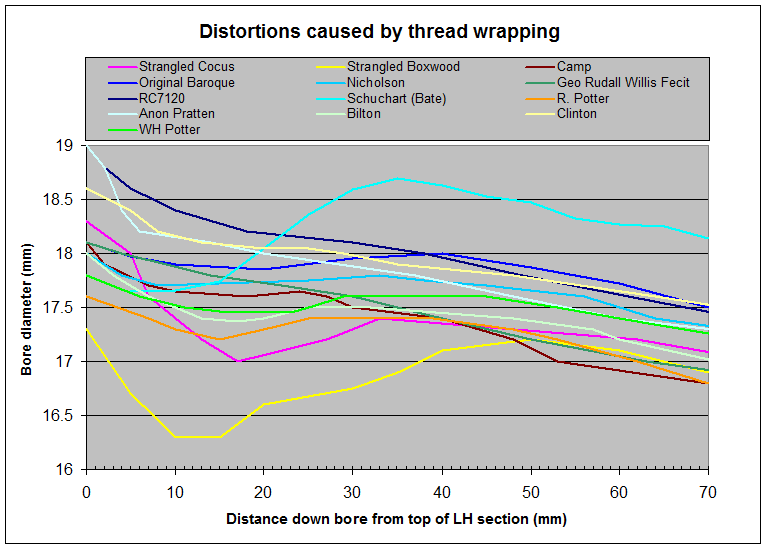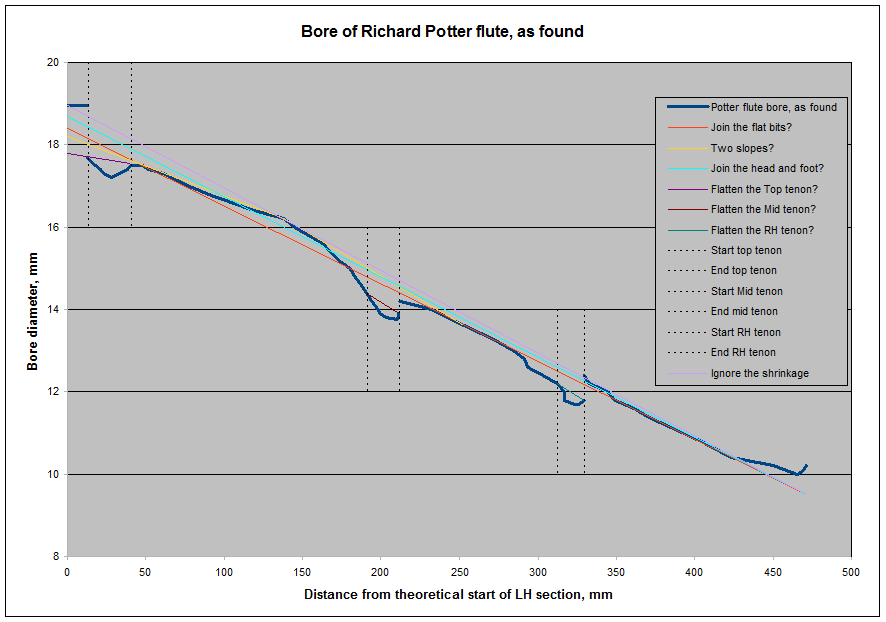Introduction
In the
first article in this
series, we met the flute we are going to be working with, and saw the
distorted shape of its bore as found. In this article, we look for
evidence of what it looked like originally. This will be your
opportunity to exercise some imagination and indulge in some detective
work.
What should the bore look
like?
That question is not immediately
answerable, but we can put some limits on the possibilities. Firstly,
let's remind ourselves what the top tenon looked like in our original survey:

Our flute is the orange trace in the graph above.
Just looking at the trace, we might think that flattening out the trace
over the region X=0 to X=26mm is all that's called for. Keep that
in mind as we look at the bigger picture.
Now let's look at the bore of the whole flute, as we saw
in the Introduction. Except this time, I've added a few guesses as
to what the original bore might have looked like. It's our job now
to decide which of these have the most merit, or to suggest other
possible original scenarios.

Scenario 1 - This is
the original bore, silly.
In scenario 1, we deny that
any compression has taken place. We regard the bulge around X=50mm
as a product of deliberate chambering, remembering Rockstro's quote:
Much was, however,
done by actual experiment to improve the defective notes of the
older instruments by "chambering", or slightly enlarging, the bore
at certain places. Some of the flutes made by the old firm of
Rudall & Rose were marvels of ingenuity in this respect.
Except of course we have no
reason to believe Potter employed chambering. We also don't really
know what Rockstro meant by chambering. Did "slightly enlarging"
mean that the bore at the particular point actually became larger than
somewhere upstream, as it has been interpreted in recent times, or
simply became a bit larger than the prevailing taper might have
suggested. I don't believe we know.
Scenario 2 - Just flatten
the bent tenons
In this scenario, we look at
the effect of flattening the squashed tenons, as we discussed further
up. The thin purple, brown and dark green lines on the three
tenons above show what would happen if we did that. What do you
think? Leaves some pretty big dips in the bore, and some pretty
large discontinuities between the bores of adjacent sections.
Scenario 3 - Two slopes in
the Left Hand section (orange)
This scenario, shown in
orange, accepts the idea that the bore was conceived as having two
slopes, meeting at the high point at about X=140, and conforming to the
current bore as far as 160mm. It accepts the notion that the maker
used more than one reamer, or a complex reamer to make the two-slope
bore, and had reasons to introduce that additional complexity. The
top tenon will need to be expanded considerably from its current
condition to conform to the upper slope. The lower tenon needs to
be expanded even more dramatically, in order for the second slope to merge
with the generality of the RH bore.
You'll notice I haven't
chosen to aim it at the start of the RH bore, because of the compression
that bore seems to have suffered there. Instead, I've aimed to pick up the
unaffected bore taper from around 235 to 290mm.
Scenario 4 - Join the flat
bits (red)
In this scenario, in thin
red, we seek out those parts of the total bore that seem to have a
chance of lining up. We allow that some parts of the LH section
might have bulged outwards, perhaps in reaction to the constriction at
the ends.
Given how well the red line
fits some parts of the LH, and most of the RH and foot, it's tempting
perhaps to think that it was the original cut, with a spot of chambering
applied to create an enlargement between around X=100 to 160mm.
But we don't know if Potter (or anyone else other than allegedly Rudall
& Rose) indulged in chambering.
Scenario 5 - Join the head
and foot (aqua)
If we were feeling
particularly bold, we might
argue that the flute originally had a single taper, joining the end of
the headjoint bore with the foot RH section. I've
illustrated that on the graph with a thin line in aqua. Note that I've
taken it from the original location of the top end of the LH section,
before the first 13mm was cut off in the late 19th century.
The severe crack in the
barrel of the Potter reminds us that the wood has shrunk around the
tuning slides by about 1.5%. So, presumably, it has shrunk
approximately equally everywhere else. The head bore cannot shrink
however, as it is lined in metal. If it did, we might expect it to
drop to about 18.6mm. So I've started the aqua line at 18.6mm to
allow for the same rate of shrinkage that appears to have occurred to
the barrel.
Scenario 6 - Ignore the
shrinkage
This most ambitions scenario
is the same as Scenario 5, excepting we choose to reject the notion of
allowing for the barrel wood shrinking. We draw a line (in
violet) that joins the head bore to the foot bore. On the plus
side, it now takes in the widest section of the original LH bore.
But it skims over the head of the RH bore, even more than Scenario 5
did.
This Scenario accepts the notion that the thread band not only causes
constriction under the tenon, but as far along as 140mm from the top, and as
far back as 170mm from the bottom of the LH section. Leaving only 30mm of original diameter
bore!
Scenario 7 - Other, please
specify
So, now it's your turn.
Hold a piece of paper up to the screen, below or above the blue trace,
whichever obscures the least. Or print out the graph and use a
pencil and rule. Look for a more likely scenario than any I have
presented so far. And let me know which scenario you support!
Don't get too excited?
Now, we don't know that
Potter et al had the capacity to make a conical bore as straight as our
scenarios demand. Dr. Robert Bigio argues that reamers even into
the mid 19th century were hand forged by blacksmiths, and therefore
restricted to simple tapers, and limited in precision. Helmholtz,
writing back in 1843, seems more confident:
"Thus the carpenter
employs only the rimer [reamer], which is a fluted tool like the
generality of his bits, as shown in Fig 518 so as to act like a
paring tool." [His image reveals that the rimer has a "("
cross section, sharpened along the edge.] "Flutes and
clarionets [period spelling] are first perforated [bored] with the
nose-bit [shell-augur], and then broached with taper holes by means
of tools of this kind, which are very carefully graduated as to
their dimensions."
Unfortunately, that's all he
tells us, so we are left to interpret "very carefully graduated"
according to our prejudices. Given that Helmholtz is a man
demanding of considerable precision in his ornamental turning engines,
perhaps we should take him pretty seriously.
Even if Potter could make a long
straight tapered bore, we know that wood moves with time, especially
boxwood as this flute is made of, so we could be seeing a lot of other
errors that have crept in over time. Against all that, some parts
of the bore do line up very well, which seems more than coincidence.
Anyway, let's keep in mind that maybe we're just trying to reading too
much into it. But that's not an excuse to throw our collective
hands up in the air, shrug our collective shoulders and exclaim
collectively that "it's
all too hard!". If we are going to cajole Mr Potter's Patent flute
back into shape, we're going to have to know what that shape was, or at
least know when we have got there.
Welcome to my world!
This is probably the first
time you've been confronted with the grim reality of what lurks inside a
period flute, and asked to make sense of it. But don't think we're
the first to venture there. Flute makers have to do this every
time they draw a new model from a period instrument, although perhaps
not always in such detail. Welcome to my world!
And flute makers not always
coming to the same conclusions. We see out there the full gamut of
possible reactions, from the "single taper" adherents to the "heavily
chambered" enthusiasts and everything in between. We can't all be right!
|